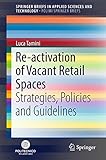Re-activation of Vacant Retail Spaces [electronic resource] : Strategies, Policies and Guidelines / by Luca Tamini.
By: Tamini, Luca [author.] .
.
Contributor(s): SpringerLink (Online service) .
.
Material type:  BookSeries: PoliMI SpringerBriefs: Publisher: Cham : Springer International Publishing : Imprint: Springer, 2018Edition: 1st ed. 2018.Description: VIII, 96 p. 28 illus., 8 illus. in color. online resource.Content type: text Media type: computer Carrier type: online resourceISBN: 9783319708720.Subject(s): Buildings—Design and construction
BookSeries: PoliMI SpringerBriefs: Publisher: Cham : Springer International Publishing : Imprint: Springer, 2018Edition: 1st ed. 2018.Description: VIII, 96 p. 28 illus., 8 illus. in color. online resource.Content type: text Media type: computer Carrier type: online resourceISBN: 9783319708720.Subject(s): Buildings—Design and constructionThis book presents an original methodology for analyzing urban retail systems, addressing the strong retail meltdown (increase in closed corner-shops and dead malls) that is severely affecting cities and suburban areas in Europe and the USA. Taking into account both spatial and regulative aspects, it offers a new approach to retailing and retail spaces developed within the urban planning field. The book describes international case studies together with solutions to the problem of vacant retail spaces, and provides a comprehensive toolbox of guidelines useful to local and regional governments facing the problem of retail meltdown. As such, it is of interest to architects, engineers, urban planners, decision-makers and government representatives. It also provides a valuable methodological reference resource for researchers engaged in this particular field of study.


There are no comments for this item.